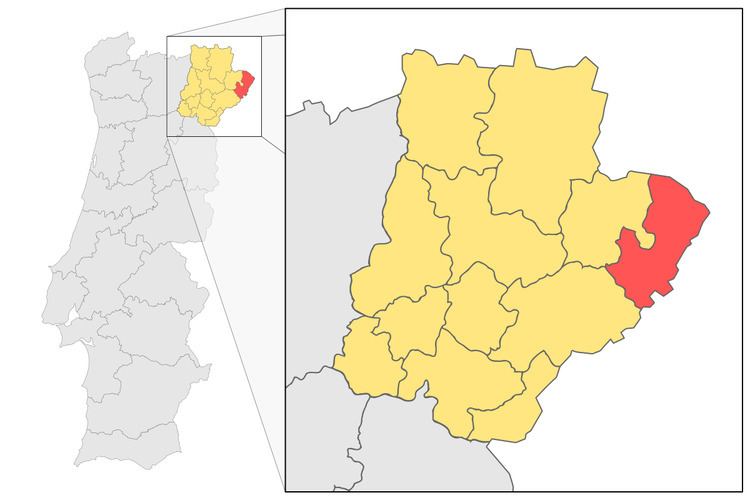 | ||
Native speakers 15,000 (2000)(10,000 use it regularly, 5,000 when they return to the area. 2,000 Sendinese in Sendim Vila.) Language family Indo-EuropeanItalicRomanceWesternIbero-RomanceWest IberianAstur-LeoneseMirandese Official language in Co-official recognition. Special protection status in Miranda do Douro, Portugal. Statutory language of provincial identity in 4 municipalities, northeast Portugal (1999, Law No. 7-99 of 29 January). Regulated by | ||
The Mirandese language (autonym: mirandés or lhéngua mirandesa; Portuguese: mirandês or língua mirandesa) is an Astur-Leonese language that is sparsely spoken in a small area of northeastern Portugal in the municipalities of Miranda do Douro, Mogadouro and Vimioso. The Assembly of the Republic granted it official recognition alongside Portuguese for local matters on 17 September 1998 with the law 7/99 of 29 January 1999.
Contents
Mirandese has a distinct phonology, morphology and syntax. It has its roots in the local Vulgar Latin spoken in the northern Iberian Peninsula.
Mirandese is a descendant of the Astur-Leonese variety spoken in the Kingdom of León and has both archaisms and innovations that differentiate it from the modern varieties of Astur-Leonese spoken in Spain. In recognition of these differences, and due to its political isolation from the rest of the Astur-Leonese speaking territory, Mirandese has adopted a different written norm than the one used in Spain for Astur-Leonese. Lexically, it shares a lot of vocabulary with Portuguese.
Speakers
In the 19th century, José Leite de Vasconcelos described it as "the language of the farms, of work, home, and love between the Mirandese". Since 1986–1987 it has been taught to students between the ages of 10 and 11, and so it is recovering.
Today Mirandese retains fewer than 5,000 speakers (but the number can be up to 15,000 if counting second-language speakers) in the villages of the Municipality of Miranda do Douro and in some eastern villages (such as Vilar Seco and Angueira; in Caçarelhos, it is considered recently extinct) of the Municipality of Vimioso, and some linguistic influence can be observed at other villages of the municipality of Vimioso and the municipalities of Mogadouro, Macedo de Cavaleiros and Bragança.
Variants
Three variants of the Mirandese language exist: Border Mirandese (Mirandés Raiano), Central Mirandese (Mirandés Central) and Sendinese (Sendinés). Most speakers of Mirandese also speak Portuguese.
The main differences between Mirandese in Portugal and the Astur-Leonese languages in Spain are caused by the dominant languages in each region. Mirandese has been influenced phonetically and in lexicon by Portuguese and the Astur-Leonese languages in Spain by Spanish (Castilian). All have distinctive orthography that phonetically reflects the respective main national languages. Another difference is that Mirandese and Leonese remain very conservative, while Asturian has undergone a greater amount of change.
Phonology
Some historical developments in Mirandese are:
Morphology
As in conservative Portuguese, Mirandese still uses the following synthetic tenses:
Sample text
The following is a sample text of the Mirandese language, written by Amadeu Ferreira, and published in the newspaper Público, on 24 July 2007.
Then a comparison of the previous text in three modern languages of the Asturo-leonese group:
National attention
Mirandese, given its status as second official language in Portugal after Portuguese, has been the subject in recent years of some publicity and attention in other parts of Portugal. A monthly chronicle in Mirandese, by researcher and writer Amadeu Ferreira, appears in the daily Portuguese national newspaper Público. The first volume of the The Adventures of Asterix, named Asterix, L Goulés (Asterix the Gaul), was published in a Mirandese translation by Amadeu Ferreira in 2005, and sold throughout Portugal. Amadeu Ferreira also translated into Mirandese the epic poem by Camões, Os Lusíadas (Ls Lusíadas), under his pseudonym Francisco Niebro and published it in 2009. In 2011, the four Gospels of the Bible's New Testament were translated into Mirandese, and in 2013 the entire Bible was translated into the language by Domingos Augusto Ferreira.
